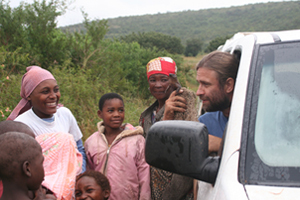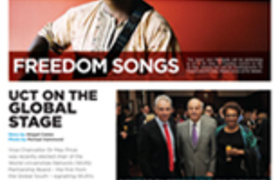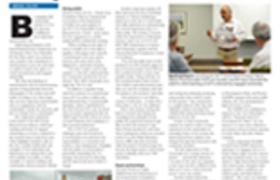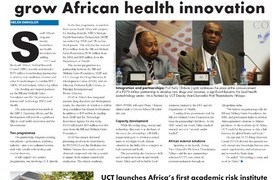Good friends in low places
17 June 2014
Author and herpetologist Marius Burger, who led the Southern African Reptile Conservation Assessment (SARCA) field surveys during the Animal Demography Unit's Reptile Atlas project, speaks to Helen Swingler about the adventures - and misadventures - of a fieldworker.
How many years of fieldwork did you put in for the Reptile Atlas?
The fieldwork component stretched over three summer seasons, during which time I travelled to priority sites all over South Africa, and clocked in excess of 100 000km.
Why the fascination with reptiles?
Ah, reptiles - my good friends in low places! Well, I guess it's a group that's generally shunned by most people, and I was fortunate to develop an alternative stance at a young age. Once I realised the fascinating ways of reptiles and their substantial diversity, I started searching for them at every opportunity. I must admit that initially it was a snake fascination. But after rolling thousands of rocks in search of snakes, or snake food, I gradually became besotted with the likes of lizards, tortoises, and frogs. In no time my fetish matured, and 'herping' became my lifetime career.
Favourite reptile?
The first contender that springs to mind is the barking gecko. These fellows gave me a good run for my money when I first tried to home in on a 'calling' individual. They seem to be expert ventriloquists, and will send you criss-crossing the desert at night in the hopes of locating the little clicker. They call from a tiny burrow in the sand, and will pull back when you approach too closely. So, in essence, you have to search for a little hole in the sand and then lie down quietly for perhaps ten minutes, while trying not to breathe. With some perseverance - and luck - you'll be rewarded when a little head pops out of the hole and stares unblinkingly into your torchlight. And then suddenly it will lick its eyeballs with its tongue - windscreen wipers for the desert dust. Other favourites include chameleons, of course. And the Gaboon viper is out to impress.
You've had a too-close encounter with a puff adder during your fieldwork. Are you okay now, or missing body parts?
I could have done without that ordeal. We were in the Waterberg region, en route to the Soutpansberg. The night before, we'd done some road cruising and collected a young African rock python, and this damned puff adder. The plan was to photograph them in the morning and then release them. But that puffie changed the schedule. Ten days in a hospital in Pretoria, four surgical procedures later, and five months for the wound to heal ... I'm happy not to have lost the thumb. It's thin and stiff, and without much sensation, but it's still there. There's no glory in getting bitten. In fact, it's an embarrassment, and an inconvenience. I would love to have reached 50 years into my herpetological career and be able to boast a bite-free track record. There goes that plan–
Favourite anecdote from the Reptile Atlas? exercise?
I enjoyed the SARCA way of life; we got to travel vast distances to explore areas that - herpetologically speaking - were poorly known. Our gap analysis would pinpoint the areas of interest, and typically I would phone an agricultural co-op in the nearest town and inquire about accommodation on a nearby farm. I loved those conversations: “Hello. My name is Marius Burger. I want to catch snakes and lizards on your farm. And I need cheap accommodation or camping for four persons for ten days. It's for a good cause.†After a longish pause I was usually asked to repeat my request again; but invariably we were swamped by hospitality, and in many cases the new friendships became lasting ones. And speaking of new friendships, a total of 61 volunteers joined me on the SARCA fieldtrips. A few, I think, have recovered reasonably well after they received post-SARCA therapy!
What's the value of citizen scientists in an endeavour like this - I imagine the general public would have been more comfortable gathering data for the butterfly or bird atlases?
The concept of citizen scientists has been well established in Europe for some decades already, but it's relatively new in SA. Some faunal groups are obviously more popular, like birds. But I must admit I was pleasantly surprised to see more-than-expected interest in SARCA, and specifically the SARCA Virtual Museum. Citizen scientists contributed a substantial chunk of the SARCA dataset, and as our society is continually transforming over the years, I anticipate that these interest groups will continue to grow.
 This work is licensed under a Creative Commons Attribution-NoDerivatives 4.0 International License.
This work is licensed under a Creative Commons Attribution-NoDerivatives 4.0 International License.
Please view the republishing articles page for more information.
News
Faculty Focus - Humanities
Opinions
Photo Essay
Front page
Previous Editions










